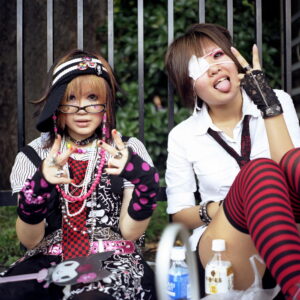With nearly 1.5 million residents, the city of Kyoto in the Kyoto Prefecture is the 7th largest city in Japan, but it’s also one of the nation’s most important cities, in terms of history and culture. The city, located about 300 miles southwest of Tokyo (and accessible from Tokyo in around 3 ½ hours by train), is centrally inland, so you can’t see the Pacific Ocean or the Sea of Japan from the city limits. The large population’s water needs are met by the plethora of locations at which a water table breaks through the ground’s surface, leading to attractive ponds and small lakes. There are also three rivers surrounding the city: the Kamogawa, the Katsuragawa, and the Ujigawa.
Home to historic locations such as the Kinkaku-ji (Golden Pavilion Temple), Kyoto was once Japan’s capital city for a period of almost 1100 years from 794 CE to 1868 CE. (There was a brief time in the 1180s CE, however, in which it was not the capital.) During this time, Kyoto was known as Heian-kyo. Kyoto was home to the imperial family for all of these years, even when the imperial family lost much of its power to the shoguns (military leaders), so it served as the nation’s capital, at least on paper. In fact, the label of “capital” was never officially transferred from Kyoto to Tokyo in the 1800s even after the imperial family moved, so there are some who believe that Kyoto remains the capital officially, despite the modern government being seated in Tokyo.
Originally modeled after the Chinese city of Xi’an (at the time the capital of the Tang Dynasty), the city of Kyoto retains much of its imperial and historical significance. There are plenty of modern buildings, but there are far more historic buildings per square mile than you would find in Tokyo and much more of the traditional history is preserved in Kyoto culture. For example, the most prestigious area of geisha culture remains in Kyoto, not Tokyo. Other sites of interest include the Heian Shrine, the Shimogamo Shrine, the Daigo-ji, Ninna-ji, and much more.
The American military knew about Kyoto’s rich cultural and historical significance to Japan and strongly considered Kyoto as a target for the atomic bomb during World War II, hoping to devastate the Japanese people’s morale by destroying so much of their history at once. However, it was spared from the atomic bomb and even from the rest of the bombings thanks to Edwin O. Reischauer, a “Japan expert” liaison to the U.S. military (and later ambassador to Japan), who had been to Kyoto and wanted to preserve its beauty.
Have you ever been to Kyoto? What’s your favorite historical site in Kyoto? Do you agree with America’s World War II decision to spare Kyoto in favor of Hiroshima, Nagasaki, Tokyo (which was devastated by firebombing), and other cities? Why or why not?
No related posts.
Tags: geisha, imperial family, japan, japanese culture, japanese history, japanese places, kyoto




